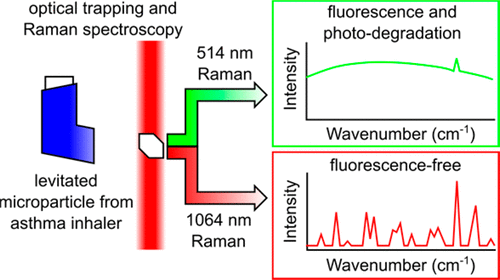当前位置:
X-MOL 学术
›
Anal. Chem.
›
论文详情
Our official English website, www.x-mol.net, welcomes your feedback! (Note: you will need to create a separate account there.)
1064 nm Dispersive Raman Microspectroscopy and Optical Trapping of Pharmaceutical Aerosols
Analytical Chemistry ( IF 7.4 ) Pub Date : 2018-06-29 00:00:00 , DOI: 10.1021/acs.analchem.8b00817 Peter J. Gallimore 1 , Nick M. Davidson 2 , Markus Kalberer 1 , Francis D. Pope 2 , Andrew D. Ward 3
Analytical Chemistry ( IF 7.4 ) Pub Date : 2018-06-29 00:00:00 , DOI: 10.1021/acs.analchem.8b00817 Peter J. Gallimore 1 , Nick M. Davidson 2 , Markus Kalberer 1 , Francis D. Pope 2 , Andrew D. Ward 3
Affiliation

|
Raman spectroscopy is a powerful tool for investigating chemical composition. Coupling Raman spectroscopy with optical microscopy (Raman microspectroscopy) and optical trapping (Raman tweezers) allows microscopic length scales and, hence, femtolitre volumes to be probed. Raman microspectroscopy typically uses UV/visible excitation lasers, but many samples, including organic molecules and complex tissue samples, fluoresce strongly at these wavelengths. Here we report the development and application of dispersive Raman microspectroscopy designed around a near-infrared continuous wave 1064 nm excitation light source. We analyze microparticles (1–5 μm diameter) composed of polystyrene latex and from three real-world pressurized metered dose inhalers (pMDIs) used in the treatment of asthma: salmeterol xinafoate (Serevent), salbutamol sulfate (Salamol), and ciclesonide (Alvesco). For the first time, single particles are captured, optically levitated, and analyzed using the same 1064 nm laser, which permits a convenient nondestructive chemical analysis of the true aerosol phase. We show that particles exhibiting overwhelming fluorescence using a visible laser (514.5 nm) can be successfully analyzed with 1064 nm excitation, irrespective of sample composition and irradiation time. Spectra are acquired rapidly (1–5 min) with a wavelength resolution of 2 nm over a wide wavenumber range (500–3100 cm–1). This is despite the microscopic sample size and low Raman scattering efficiency at 1064 nm. Spectra of individual pMDI particles compare well to bulk samples, and the Serevent pMDI delivers the thermodynamically preferred crystal form of salmeterol xinafoate. 1064 nm dispersive Raman microspectroscopy is a promising technique that could see diverse applications for samples where fluorescence-free characterization is required with high spatial resolution.
中文翻译:

药物气溶胶的1064 nm色散拉曼光谱和光学陷印
拉曼光谱法是研究化学成分的有力工具。将拉曼光谱与光学显微镜(拉曼显微光谱)和光阱(拉曼镊子)耦合,可以观察到微观的长度刻度,因此可以探测飞镖的体积。拉曼光谱通常使用紫外线/可见光激发激光,但是许多样品(包括有机分子和复杂的组织样品)在这些波长下会发出强烈的荧光。在这里,我们报道了围绕近红外连续波1064 nm激发光源设计的色散拉曼光谱技术的开发和应用。我们分析了由聚苯乙烯乳胶和三种用于治疗哮喘的现实世界加压计量吸入器(pMDIs)组成的微粒(直径为1-5μm):沙美特罗xinafoate(Serevent),硫酸沙丁胺醇(Salamol)和ciclesonide(Alvesco)。首次使用相同的1064 nm激光捕获,光学悬浮和分析单个颗粒,从而可以对真正的气溶胶相进行方便的非破坏性化学分析。我们表明,使用可见激光(514.5 nm)表现出压倒性荧光的粒子可以成功地以1064 nm激发进行分析,而与样品成分和照射时间无关。快速获得光谱(1-5分钟),在宽波数范围(500-3100厘米)中具有2 nm的波长分辨率 我们表明,使用可见激光(514.5 nm)表现出压倒性荧光的粒子可以成功地以1064 nm激发进行分析,而与样品成分和照射时间无关。快速获得光谱(1-5分钟),在宽波数范围(500-3100厘米)中具有2 nm的波长分辨率 我们表明,使用可见激光(514.5 nm)表现出压倒性荧光的粒子可以成功地以1064 nm激发进行分析,而与样品成分和照射时间无关。快速获得光谱(1-5分钟),在宽波数范围(500-3100厘米)中具有2 nm的波长分辨率–1)。尽管有微观的样品大小和1064 nm的低拉曼散射效率。单个pMDI颗粒的光谱与大量样品相比非常好,并且Serevent pMDI提供了沙美特罗新萘甲酸的热力学上优选的晶体形式。1064 nm色散拉曼光谱技术是一种很有前途的技术,可以用于需要高空间分辨率无荧光表征的样品的各种应用。
更新日期:2018-06-29
中文翻译:

药物气溶胶的1064 nm色散拉曼光谱和光学陷印
拉曼光谱法是研究化学成分的有力工具。将拉曼光谱与光学显微镜(拉曼显微光谱)和光阱(拉曼镊子)耦合,可以观察到微观的长度刻度,因此可以探测飞镖的体积。拉曼光谱通常使用紫外线/可见光激发激光,但是许多样品(包括有机分子和复杂的组织样品)在这些波长下会发出强烈的荧光。在这里,我们报道了围绕近红外连续波1064 nm激发光源设计的色散拉曼光谱技术的开发和应用。我们分析了由聚苯乙烯乳胶和三种用于治疗哮喘的现实世界加压计量吸入器(pMDIs)组成的微粒(直径为1-5μm):沙美特罗xinafoate(Serevent),硫酸沙丁胺醇(Salamol)和ciclesonide(Alvesco)。首次使用相同的1064 nm激光捕获,光学悬浮和分析单个颗粒,从而可以对真正的气溶胶相进行方便的非破坏性化学分析。我们表明,使用可见激光(514.5 nm)表现出压倒性荧光的粒子可以成功地以1064 nm激发进行分析,而与样品成分和照射时间无关。快速获得光谱(1-5分钟),在宽波数范围(500-3100厘米)中具有2 nm的波长分辨率 我们表明,使用可见激光(514.5 nm)表现出压倒性荧光的粒子可以成功地以1064 nm激发进行分析,而与样品成分和照射时间无关。快速获得光谱(1-5分钟),在宽波数范围(500-3100厘米)中具有2 nm的波长分辨率 我们表明,使用可见激光(514.5 nm)表现出压倒性荧光的粒子可以成功地以1064 nm激发进行分析,而与样品成分和照射时间无关。快速获得光谱(1-5分钟),在宽波数范围(500-3100厘米)中具有2 nm的波长分辨率–1)。尽管有微观的样品大小和1064 nm的低拉曼散射效率。单个pMDI颗粒的光谱与大量样品相比非常好,并且Serevent pMDI提供了沙美特罗新萘甲酸的热力学上优选的晶体形式。1064 nm色散拉曼光谱技术是一种很有前途的技术,可以用于需要高空间分辨率无荧光表征的样品的各种应用。



























 京公网安备 11010802027423号
京公网安备 11010802027423号